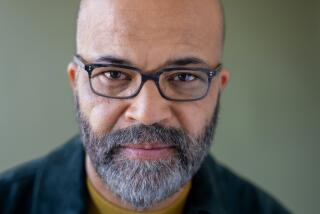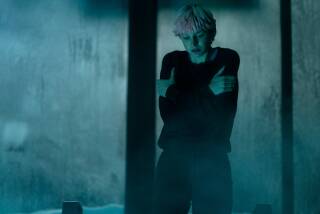Vision lives on paper
In 1937 a little-known author named Ayn Rand wrote to revered modernist Frank Lloyd Wright.
“Dear Mr. Wright,” her letter of Dec. 12 began, “I am writing a novel about the career of an architect. . . . I should like to have the privilege of meeting you and discussing it with you.”
The book, “The Fountainhead,” was published six years later. Although Wright did not make himself available in 1937 or for years to come, Rand’s pitch was the start of a two-decade correspondence that evolved into a robust exchange of ideas as well as this: a preliminary rendering of a “cottage studio,” in colored pencil on paper, that the legendary architect crafted for Rand. It is featured in “Drawings and Objects by Architects,” on exhibit through Oct. 10 at the Edward Cella Art + Architecture gallery in the mid-Wilshire area of L.A.
The “Cottage Studio for Ayn Rand” drawing carries a “price upon request” notice -- an indication of its specialness amid dazzling works by architect Richard Neutra, Wright photographer Pedro E. Guerrero, architectural illustrator Carlos Diniz and others. Suffice to say that, for the amount Cella has in mind, one could buy a perfectly reasonable condo.
“Cottage studio” is an unlikely term for an imposing, cantilevered building with horizontal bands of fieldstone. Asymmetric terraces of concrete or stucco radiate off a vertical spine, perhaps a chimney, and seem to float on ribbons of clerestory windows.
With expressive gestures, Wright suggests cascading vines and fountains to soften the composition of hard materials. A writing studio was to be placed at the top of the tower with louvered windows to capture light, ocean views and air. Rand (1905-82) expressed her delight in an October 1946 letter to Wright:
“The house you designed for me is magnificent. I gasped when I saw it. It is the particular kind of sculpture in space which I love and which nobody but you has ever been able to achieve.
“I was not very coherent when I told you what kind of house I wanted -- and I had the impression that you did not approve of what I said,” she went on. “Yet you designed exactly the house I hoped to have. The next time somebody accuses you of cruelty and inconsideration toward clients, refer them to me.”
The letter is one of hundreds in the posthumous 1995 collection “Letters of Ayn Rand” edited by Michael S. Berliner.
The temperamental Wright is widely regarded as an inspiration for Howard Roark, the uncompromising protagonist of “The Fountainhead,” an architect whose insistence on designing modernist structures clashes with the tradition-worshiping establishment. Rand and Wright didn’t meet until a year after the book came out, but for the next three years they communicated about plans for the cottage studio in Connecticut.
In notes for the Edward Cella exhibition, architectural historian and author Nicholas Olsberg said that by the time Wright was ready to develop the design in detail, Rand had moved to California to work on the movie version of “The Fountainhead,” starring Gary Cooper. With a Hollywood career in mind, she apparently toyed with the possibility of buying a hillside lot with an ocean view. Rand ultimately decided not to leave Manhattan and never seriously sought a site for the project in California or Connecticut.
Cella said the final drawing for Rand’s cottage studio is part of the holdings of the Frank Lloyd Wright Foundation at Taliesin West, the campus he founded in Scottsdale, Ariz.
The preliminary rendering on view in L.A. is signed with the angular Wright “chop,” with two initial Ls. (He was born Frank Lincoln Wright, but his name was changed after his father, William Carey Wright, and mother, Anna Lloyd-Jones, divorced.) Olsberg said he would attribute the drawing to Wright and John H. Howe, a draftsman with whom Wright worked.
That the project was never realized might not be a bad thing.
“Some of the most fascinating homes never get built,” said Cella, who recently relocated his gallery from Santa Barbara. “Even the greatest architects have compromises along the way. These [drawings] are utopian, the purest vision, visual poetry.”
Wright and Rand eventually met a number of times. “She had the utmost admiration for him, but not at all the ideas he espoused,” said Berliner, an advisor to the Rand archives. Wright was “sort of leftist” and populist in his political views, he said, in stark contrast with Russia-born Rand, whose “objectivism” espoused individual rights and opposed collectivism.
In “The Fountainhead,” modern architecture provided a convenient vehicle for her views. In her 1937 letter, she told Wright that her new novel “is to be the story of an architect who follows his own convictions throughout his life, no matter what society thinks of it or does to him. . . . A man who has an ideal and goes through hell for it. So you can understand why it seems to me that of all men on earth you are the one I must see.”
But she added: “My hero is not you. I do not intend to follow in the novel the events of your life and career. His life will not be yours, nor his work, perhaps not even his artistic ideals. But his spirit is yours -- I think.”
--
More to Read
The biggest entertainment stories
Get our big stories about Hollywood, film, television, music, arts, culture and more right in your inbox as soon as they publish.
You may occasionally receive promotional content from the Los Angeles Times.











